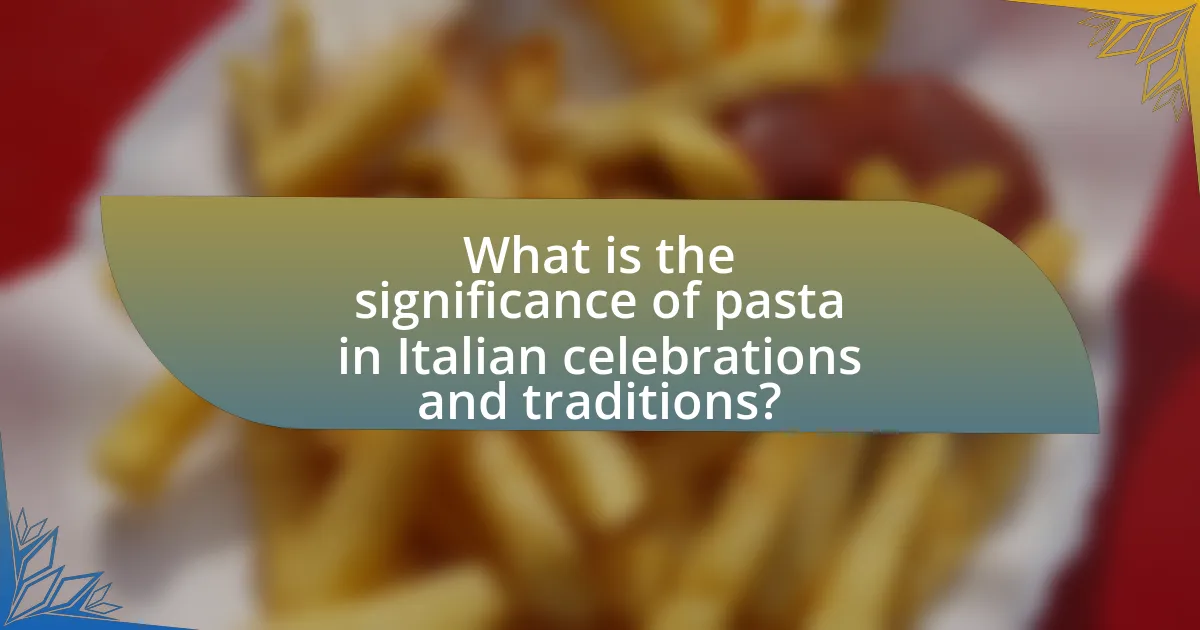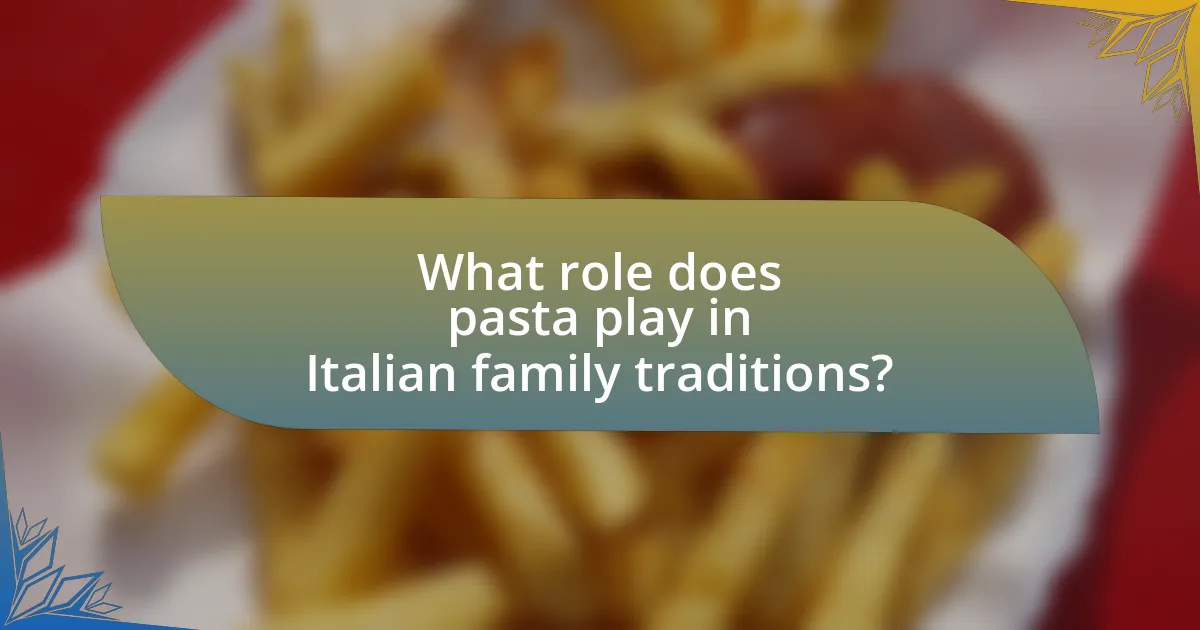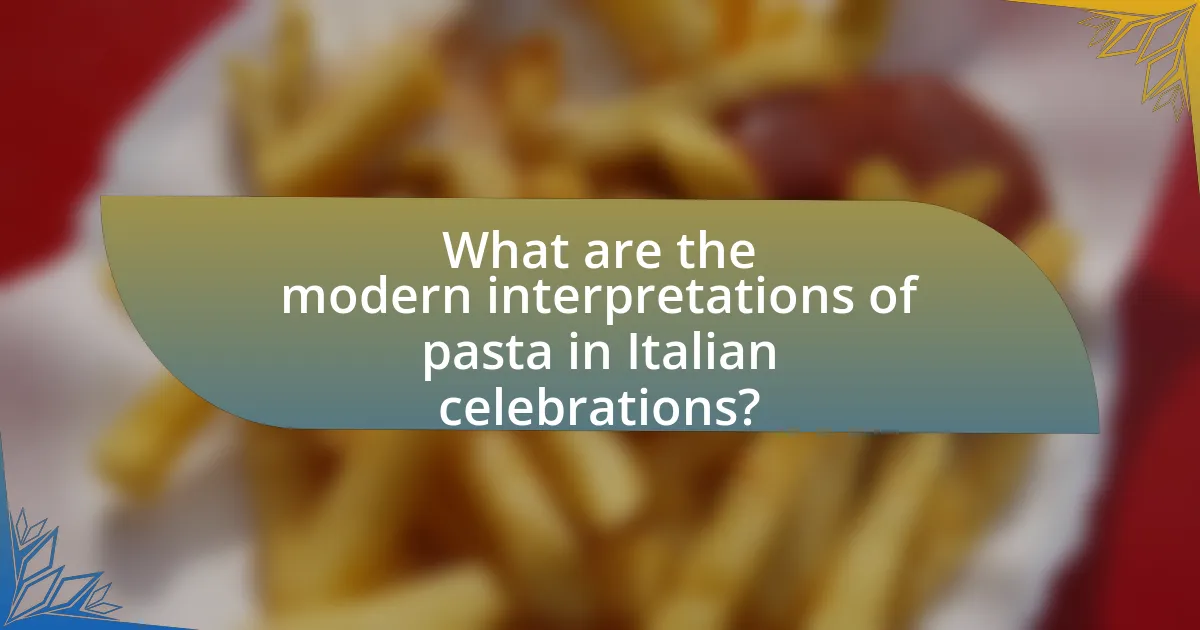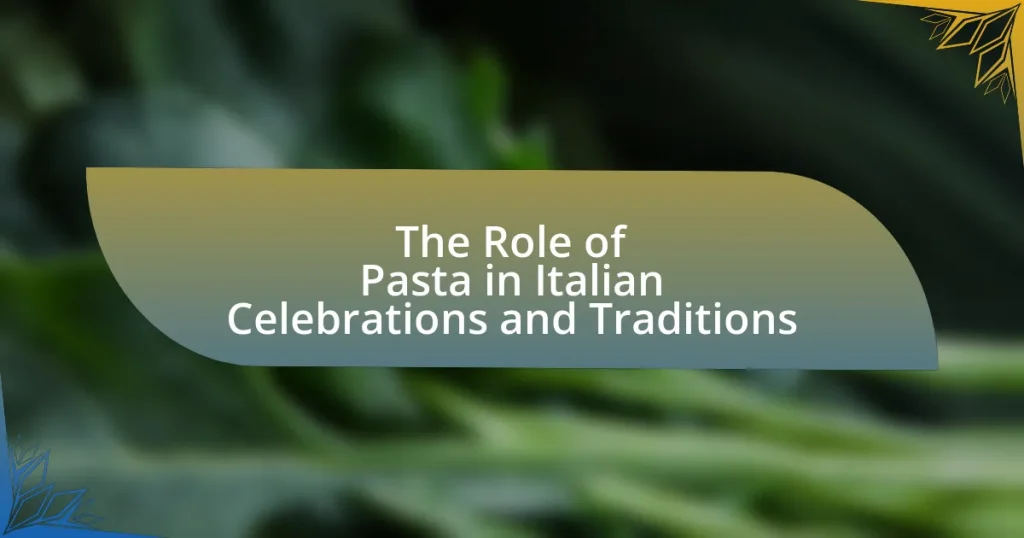Pasta is a fundamental element of Italian culture, deeply embedded in the country’s celebrations and traditions. It symbolizes unity and family, often featured in festive meals during major holidays such as Christmas and Easter, with specific dishes like lasagna and tortellini representing regional culinary heritage. The article explores the historical significance of pasta, its evolution into a staple food, and the regional diversity that influences various pasta types across Italy. Additionally, it examines the role of pasta in family gatherings, the importance of homemade pasta, and modern interpretations that reflect changing culinary trends. Through this exploration, the article highlights how pasta continues to shape Italian identity and cultural practices.

What is the significance of pasta in Italian celebrations and traditions?
Pasta holds significant cultural importance in Italian celebrations and traditions, symbolizing unity and family. It is a staple dish served during major holidays such as Christmas and Easter, where specific pasta types are associated with traditional recipes, like lasagna for Christmas and tortellini in broth for New Year’s Eve. The preparation and sharing of pasta dishes during these occasions foster communal bonds and reflect regional culinary heritage, as different areas of Italy have unique pasta traditions. For instance, in Southern Italy, pasta is often featured in festive meals, highlighting its role in both daily life and special events.
How has pasta become a staple in Italian culture?
Pasta has become a staple in Italian culture due to its deep historical roots and versatility in traditional cuisine. Originating in Italy during the 12th century, pasta was initially a luxury item but gradually became accessible to the masses, leading to its integration into everyday meals. The establishment of regional pasta varieties, such as spaghetti in Naples and ravioli in Liguria, reflects local ingredients and culinary practices, further embedding pasta into the cultural identity of Italy. Additionally, pasta is central to numerous Italian celebrations and family gatherings, symbolizing unity and tradition, as seen in dishes served during holidays like Christmas and Easter. This cultural significance is reinforced by Italy’s designation of pasta as a key element of its gastronomic heritage by UNESCO in 2010, highlighting its importance in Italian life.
What historical events contributed to pasta’s prominence in Italy?
Pasta’s prominence in Italy was significantly influenced by the introduction of durum wheat cultivation in the 8th century, which allowed for the production of high-quality pasta. The establishment of trade routes during the Middle Ages facilitated the spread of pasta across Italy, making it a staple food. Additionally, the 19th-century unification of Italy helped standardize regional pasta varieties, further embedding pasta into Italian culture. The 20th century saw the global rise of Italian cuisine, with pasta becoming synonymous with Italian identity, as evidenced by its inclusion in traditional celebrations and everyday meals.
How does regional diversity influence pasta types in Italy?
Regional diversity significantly influences pasta types in Italy by reflecting local ingredients, traditions, and culinary practices. Each region utilizes its unique agricultural products, such as durum wheat in the south and softer wheat in the north, leading to distinct pasta shapes and textures. For example, in Emilia-Romagna, fresh egg pasta like tagliatelle is prevalent, while in Campania, dried pasta shapes like ziti are more common. This variety is further enriched by local customs and celebrations, where specific pasta dishes are prepared for traditional festivities, such as orecchiette in Puglia for family gatherings. The regional differences in pasta types illustrate Italy’s rich cultural heritage and the importance of local resources in shaping culinary identity.
Why is pasta associated with specific Italian holidays?
Pasta is associated with specific Italian holidays due to its cultural significance and traditional recipes that vary by region and occasion. For example, during Christmas, dishes like lasagna or tortellini are commonly served, symbolizing family gatherings and festive celebrations. Additionally, Easter features pasta dishes such as “timballo” or “pasta al forno,” which reflect the season’s themes of renewal and abundance. These associations are rooted in Italy’s culinary history, where pasta has been a staple food for centuries, often prepared in special ways to mark important events and religious observances.
What traditional pasta dishes are prepared during major Italian festivals?
Traditional pasta dishes prepared during major Italian festivals include Lasagna, typically served during Christmas, and Orecchiette with broccoli rabe, commonly enjoyed during the Feast of Saint Joseph. Lasagna, made with layers of pasta, meat, and cheese, has historical significance as a festive dish, while Orecchiette, a regional specialty from Puglia, reflects local culinary traditions associated with celebrations. These dishes exemplify the cultural importance of pasta in Italian festivities, showcasing regional variations and seasonal ingredients.
How do family gatherings influence pasta consumption during celebrations?
Family gatherings significantly increase pasta consumption during celebrations due to cultural traditions and communal dining practices. In Italian culture, pasta is a staple dish often served during family events, symbolizing unity and togetherness. Research indicates that during festive occasions, such as weddings and holidays, families typically prepare larger quantities of pasta dishes to accommodate the gathering, reinforcing the social aspect of sharing meals. For instance, a study by the Italian National Institute of Statistics shows that pasta consumption peaks during holidays, with families consuming up to 30% more pasta compared to regular days. This trend highlights the integral role of pasta in fostering familial bonds and enhancing the celebratory atmosphere.

What role does pasta play in Italian family traditions?
Pasta serves as a central element in Italian family traditions, symbolizing unity and cultural heritage. It is often the centerpiece of family gatherings, particularly during Sunday meals and festive occasions, where recipes are passed down through generations, reinforcing familial bonds. Historical context shows that pasta has been a staple in Italian cuisine since the 12th century, with regional variations reflecting local ingredients and customs, thus highlighting its significance in regional identity and family rituals.
How do Italian families incorporate pasta into their daily lives?
Italian families incorporate pasta into their daily lives by making it a staple in their meals, often serving it multiple times a week. Pasta is typically prepared in various forms, such as spaghetti, penne, or lasagna, and is accompanied by a range of sauces, vegetables, and proteins, reflecting regional culinary traditions. For instance, in southern Italy, families may favor tomato-based sauces, while in the north, creamy sauces are more common. This regular consumption is supported by the fact that pasta is affordable, versatile, and easy to prepare, making it an ideal choice for both everyday meals and special occasions. Additionally, pasta dishes are often shared during family gatherings, reinforcing social bonds and cultural heritage.
What are the common pasta recipes passed down through generations?
Common pasta recipes passed down through generations include spaghetti carbonara, lasagna, and fettuccine alfredo. Spaghetti carbonara, originating from Rome, combines eggs, cheese, pancetta, and pepper, reflecting traditional Roman flavors. Lasagna, a layered dish with pasta, meat, cheese, and sauce, has roots in Emilia-Romagna and is often served during family gatherings and holidays. Fettuccine alfredo, created in the early 20th century, features a creamy sauce made from butter and Parmesan cheese, popularized in the United States but rooted in Italian culinary traditions. These recipes exemplify the cultural significance of pasta in Italian celebrations and family traditions.
How do family rituals surrounding pasta enhance cultural identity?
Family rituals surrounding pasta enhance cultural identity by fostering a sense of belonging and continuity among generations. These rituals, such as preparing traditional pasta dishes during family gatherings or holidays, serve as a means of transmitting cultural values and culinary heritage. For instance, the practice of making fresh pasta from scratch is often passed down through families, reinforcing connections to Italian heritage and traditions. This transmission of knowledge not only preserves recipes but also strengthens familial bonds, as shared meals become a celebration of cultural identity. Additionally, specific pasta dishes are often associated with regional customs, further embedding local cultural identity within the broader Italian context.
Why is homemade pasta valued in Italian households?
Homemade pasta is valued in Italian households for its cultural significance and the tradition of family bonding it fosters. The preparation of pasta from scratch is often a communal activity, bringing family members together, especially during special occasions and celebrations. This practice not only preserves culinary heritage but also enhances the flavor and texture of the dish, as fresh pasta is known to have superior quality compared to store-bought varieties. Additionally, homemade pasta allows for customization in ingredients and shapes, reflecting regional identities and personal preferences, which further solidifies its importance in Italian culinary traditions.
What techniques are used in making traditional homemade pasta?
Traditional homemade pasta is made using techniques such as mixing, kneading, rolling, and cutting the dough. The process begins with combining flour and eggs to create a dough, which is then kneaded until smooth and elastic, typically for about 10 minutes. After kneading, the dough is allowed to rest, which helps to relax the gluten. Once rested, the dough is rolled out using a pasta machine or a rolling pin to achieve the desired thickness. Finally, the rolled dough is cut into various shapes, such as tagliatelle or lasagna sheets. These techniques have been passed down through generations, emphasizing the importance of texture and flavor in traditional Italian cuisine.
How does the process of making pasta strengthen family bonds?
The process of making pasta strengthens family bonds by fostering collaboration and shared experiences among family members. When families gather to prepare pasta, they engage in a collective activity that encourages communication, teamwork, and the passing down of culinary traditions. This shared experience not only creates lasting memories but also reinforces familial ties through the enjoyment of a common goal—creating a meal together. Research indicates that cooking together can enhance relationships by promoting positive interactions and emotional connections, making the act of pasta-making a meaningful family tradition in Italian culture.

What are the modern interpretations of pasta in Italian celebrations?
Modern interpretations of pasta in Italian celebrations include innovative dishes that blend traditional recipes with contemporary culinary techniques and global flavors. For instance, chefs often experiment with pasta shapes and fillings, incorporating ingredients like seafood, truffles, or even plant-based alternatives to cater to diverse dietary preferences. Additionally, pasta is frequently featured in celebratory meals, such as weddings and holidays, where it symbolizes abundance and family unity. This evolution reflects a growing trend towards personalization and creativity in Italian cuisine, while still honoring the cultural significance of pasta as a staple in festive gatherings.
How have contemporary chefs redefined traditional pasta dishes?
Contemporary chefs have redefined traditional pasta dishes by incorporating global flavors, innovative techniques, and alternative ingredients. For instance, chefs now experiment with non-traditional sauces, such as using miso or coconut milk, to create unique flavor profiles that diverge from classic Italian recipes. Additionally, the use of gluten-free and plant-based pasta options has expanded accessibility and appeal, catering to dietary preferences and restrictions. This evolution reflects a broader culinary trend where chefs blend cultural influences, as seen in dishes like ramen-inspired pasta or pasta served with Asian-style broths, demonstrating a fusion of culinary traditions while maintaining the essence of pasta as a staple in Italian cuisine.
What fusion cuisines incorporate pasta in innovative ways?
Fusion cuisines that incorporate pasta in innovative ways include Asian-Italian, where dishes like ramen carbonara blend traditional Italian carbonara with Japanese ramen noodles. Another example is the Mexican-Italian fusion, which features pasta in dishes like lasagna tacos, combining lasagna elements with taco flavors. Additionally, Mediterranean fusion often uses pasta in salads or as a base for grilled meats, integrating flavors from various Mediterranean cultures. These innovative combinations showcase how pasta can adapt to diverse culinary traditions while maintaining its core characteristics.
How do modern celebrations reflect changing attitudes towards pasta?
Modern celebrations reflect changing attitudes towards pasta by showcasing its versatility and integration into diverse culinary traditions. For instance, pasta is no longer confined to traditional Italian dishes; it is now featured in fusion cuisines and innovative recipes that appeal to global palates. This shift is evidenced by the rise of pasta-themed events, such as the annual Pasta Festival in New York City, which celebrates various interpretations of pasta from around the world, highlighting its adaptability. Additionally, social media trends demonstrate a growing interest in unique pasta dishes, with hashtags like #PastaArt gaining popularity, indicating a cultural embrace of pasta beyond its historical roots.
What are some tips for preparing pasta for Italian celebrations?
To prepare pasta for Italian celebrations, focus on using high-quality ingredients and traditional techniques. Start with fresh pasta made from durum wheat semolina, as it provides a superior texture and flavor. Cooking the pasta in well-salted water ensures it is seasoned properly, enhancing the overall dish. Additionally, consider pairing the pasta with authentic sauces, such as a rich ragù or a simple aglio e olio, to highlight the flavors. Serving pasta al dente is crucial, as it maintains the ideal bite and texture, which is a hallmark of Italian cuisine. These practices are rooted in Italian culinary traditions, emphasizing quality and authenticity in festive meals.
How can one choose the right pasta for different occasions?
To choose the right pasta for different occasions, consider the type of sauce and the meal’s formality. For lighter sauces like olive oil or pesto, thin pastas such as spaghetti or linguine are ideal, while hearty sauces like Bolognese pair well with thicker pastas like fettuccine or pappardelle. For formal events, stuffed pastas like ravioli or tortellini can elevate the dish, while casual gatherings may suit simpler shapes like penne or fusilli. This selection is supported by traditional Italian culinary practices, where pasta shapes are often matched to specific sauces to enhance flavor and texture.
What are the best practices for cooking and serving pasta at gatherings?
The best practices for cooking and serving pasta at gatherings include cooking pasta al dente, using ample salted water, and serving it immediately with the appropriate sauce. Cooking pasta al dente ensures it retains a firm texture, which is preferred in Italian cuisine. Using a large pot with plenty of salted water enhances flavor and prevents sticking. Serving pasta immediately after cooking, ideally in a warmed dish, maintains its temperature and texture, allowing guests to enjoy it at its best. Additionally, pairing pasta with sauces that complement its type, such as tomato-based sauces for spaghetti or creamy sauces for fettuccine, enhances the overall dining experience.















